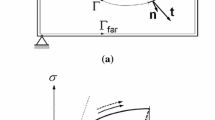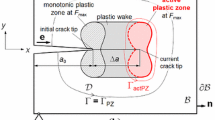Abstract
Recognizing that fracture in many materials propagates as a crack preceded by intensive damage, a theory is presented to model the crack and the preceding damage as a single thermodynamic entity, i.e., a crack layer (CL). The active zone of the CL may propagate by translational, rotational, expansional and/or distortional movements. Concepts of irreversible thermodynamics are employed to derive the law of CL propagation by translational mode as:
wherei is the rate of CL translation,β is a dissipative coefficient,J 1 is the energy release rate, 〈d〉 is a characteristic size of the active zone, γ* is the specific enthalpy of damage andR 1 is the translational resistance moment. This expression describes the entire history of CL propagation. Experimental results on fatigue crack propagation in polystryrene are in good agreement with the proposed formalism.
Similar content being viewed by others
References
A. Chudnovsky, “Principles of Statisical Theory of Long Term Strength”, (Novosibersk Electrotechnical Institute, Novosibersk, USSR, (1977).
Idem, “A Theory of Long Time Strength in Fatigue and Creep”, NSF Workshop on “A Continuum Mechanics Approach to Damage and Life Prediction”, University of Cincinnati, May 1980, (National Science Foundation, Washington D.C.) pp. 79–87.
V. Khandogen, andA. Chudnovsky, in “Dynamics and Strength of Aircraft Construction”, edited by L. Kurshin (Novosibersk, 1978).
M. Bakar, A. Moet andA. Chudnovsky, International Conference on Fatigue in Polymers (The Rubber and Plastics Institute, London, June 1983) paper 8.
A. Chudnovsky andM. L. Kachanov,Appl. Eng. Sci. Lett. 21 (1983) 1009.
A. Chudnovsky, A. Moet, R. J. Bankert andM. T. Takemori,J. Appl. Phys. 54 (1983) 5562.
J. Botsis, A. Moet andA. Chudnovsky,Annual Technical Conference Society of Plastics Engineers,XXIX (1983) 444.
K. Sehanobish, E. Baer, A. Chudnovsky andA. Moet,Bull. Amer. Phys. Soc. 29 (1984) 530.
A. Chudnovsky andYu Shraiber,J. Mech. of Solids,N3 (1974) 336.
M. Kitagawa,J. Mater Sci. 17 (1982) 2514.
J. Botsis, A. Moet andA. Chudnovsky,to be published.
N. Haddaoui, A. Chudnovsky andA. Moet,Polym. Mater. Sci. Eng. 49 (1983) 117.
A. Chudnovsky andM. Bessendorf, “Crack Layer Morphology and Toughness Characterization in Steels”, NASA report 168154, May 1983.
D. Clarke, “Process Zone Mechanisms in Ceramics”, in The Conference on Crack Tip Structure and Processes, National Bureau of Standards, June 1983.
R. G. Hoagland, G. H. Han andA. R. Rosenfield,Rock Mech. 5 (1974) 77.
A. Dolgapolsky, “Elastic Interaction of a Crack with Microcracks”, PhD Thesis, Case Western Reserve University, August 1983.
A. Chudnovsky, NASA report No. 174634, March 1984.
J. Botsis, A. Chudnovsky, A. Moet andK. Sehanobish, “Comparative Analysis of Crack Layer Propagation in Stable and Unstable Configuration”, 17th National Symposium on Fracture Mechanics, Albany, New York, August 1984 (American Society for Testing and Materials, Philadelphia).
Author information
Authors and Affiliations
Rights and permissions
About this article
Cite this article
Chudnovsky, A., Moet, A. Thermodynamics of translational crack layer propagation. J Mater Sci 20, 630–635 (1985). https://doi.org/10.1007/BF01026535
Received:
Accepted:
Issue Date:
DOI: https://doi.org/10.1007/BF01026535




